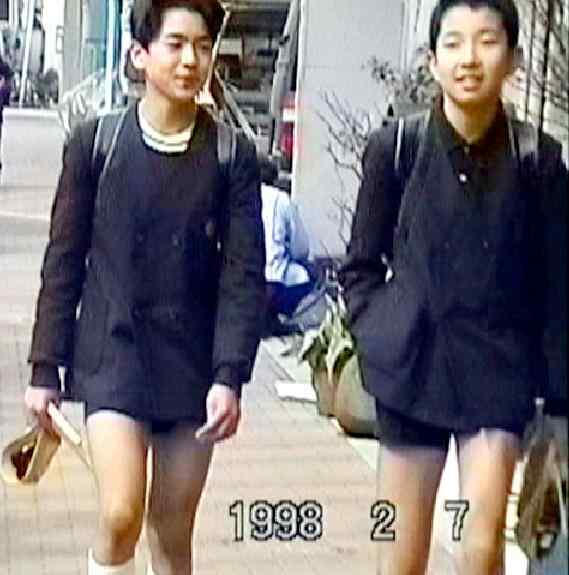
Japanese School Uniform: Bright Colored Caps

Figure 1.--This image shows a primary school boy in 1998 at a school requiring yellow caps. Children at this school can choose their shirts although a blue jacket and blue short pants are required. They also have the knapsack ("Randsell") commonly used by Japanance children. .
|
We note that some primary schools have a yellow cap. The yellow color has been selected because it is a bright color and helps ensure that motorists will see the children when they are walking to and from school. This is not an unrealistic concern. Many Japanese cities havet very narrow and crowded streets, epecially in the city centers. Japan is a heavily urbanized country and most children walk to school, especially primary school children. Thus this precaution is a very prudent one. Not all schools have adopted yellow caps, but quite a number have done so. We are not sure just what percentage of schools have these caps. Styles varry, but the most common is a style of floppy cap. Because the yellow caps are a measure to protect young children. Some of the older boys at the schools do not like having to wear the yellow caps.
Traffic Saftey
We note that some primary schools have a yellow cap. Some also have orage caps. The yellow and orange colored caps have been selected because they are a bright color and helps ensure that motorists will see the children when they are walking to and from school. This is not an unrealistic concern. Many Japanese cities havet very narrow and crowded streets, epecially in the city centers. Japan is a heavily urbanized country and most children walk to school, especially primary school children. Thus this precaution is a very prudent one.
Another purpose of the brightly colored caps was to help identify the children, especially on school trips. Many Japanese schools had blue uniforms, blue jackets, white shirts, and blue shorts. This made it hard to keep the children in sight, especially when trips were made to museums and parks where other school groups might be present. Thus the brightly colored caps made it much easier to keep track of school groups. Unlike the very similar uniforms, the caps were more varied and thus easy to spot the children in a school group with a quick glance. Some schools chose caps like blue caps to match the rest of the uniform, but brightly colored caps that did not match the rest of the uniform was a popular alternative at many schools.
School Rule
The schools which have adopted these yellow caps have made them a requirement. The schools involved are both schools which have uniforms and those that don't require uniforms. The children are required to wear them when traveling to and from school. Often a teacher will be at the dchool gate to make sure the children are wearing their caps when they arrive at school in the morning and when they leave school in the afternoon.
Extent
Not all schools have adopted these yellow traffic saftey yellow caps, but quite a number have done so. We are not sure just what percentage of schools have these caps.
Styles
Styles varry, but the most common is a style of floppy cap. We have seen these same caps worn in other colors than the bright saftey colors. The most common color is blue.

Figure 2.-- Note that the boys here who attend the same school as the boy above have not put their required yellow caps on their heads, but instead are holding them in their hands. Actually it is a violation of school rules. These are the older boys at the school and are shy about wearing a cap they believe is for little children.
|
Yellow school caps in Japan are strongly associated with younger children and school saftey. Yeloow is not, however, the only color. We have also noted other bright colors such as red and orange. We are not sure about the relative importance of these different colors. Nor do we know if preferences have changed over time.Some schools have caps more in keeping wiyh uniform colors, often blue. Other schools emphasize the bright saftey colors. This includes both schools with and wuthout uniforms. The cap saftey colors are used regardless of the uniform colors by many schools. Thus boys weaeing the bright colored caps continue to wear standard uniforms, primarily white shirts and blue shorts. We know of now schools which have attempted to adapt these bright colors to the rest of the uniform. One might think one single color like yellow might be useful. The different colors, however, have an advantage in idebtifying thge children. This is especially true on school outings and because so many schools have similar uniforms.
Popularity
Most primary-age boys have no problem with these yellow caps. The younger children don't mind wearing them. Because the yellow caps are a measure to protect young children, some of the older boys at the schools do not like having to wear the yellow caps.
School Rules
Note that they have not put their required yellow caps on their head, but instead are holding them in their hands. Actually it is a violation of school rules. These are the older boys at the school and are shy about wearing a cap they believe is for little children. The boys here are about 12 years old and no longer want to be seem as little kids. If a teacher were to see them without their caps, he or she would reprimand them are make them stay after school to clean the classroom.
HBC-SU

Related Cap Pages in the Boys' Historical Web Site
[Main Japanese school cap page]
[Main school uniform cap page]
[Main cap page]
[American caps]
[Australian caps]
[English caps]
[Japanese caps]
[New Zealand caps]
[Scottish caps]
Created: May 2, 2002
Last updated: 3:28 AM 11/7/2004





